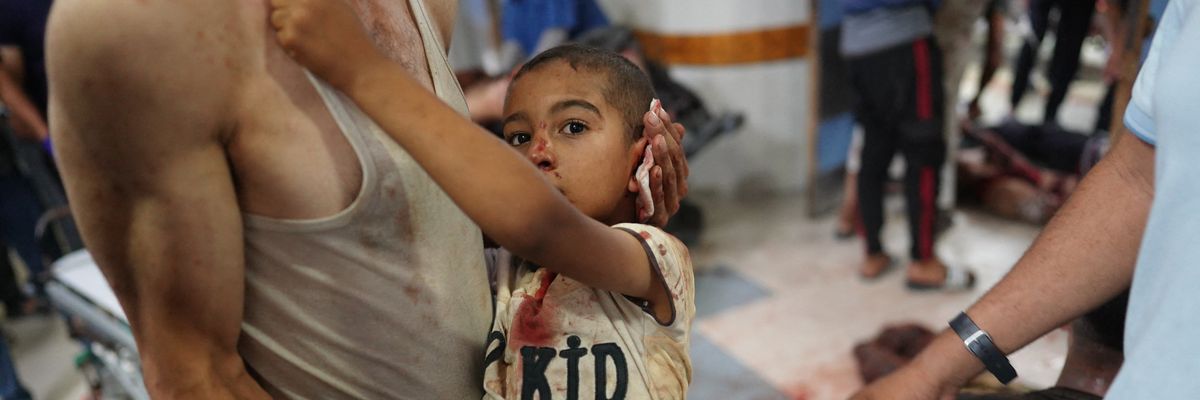Doctors who have had to perform "a constant flow of amputations" on injured children in Gaza said Thursday that the injuries they have witnessed were consistent with the use of "fragmentation bombs" loaded with shrapnel—which Israel has used in the past and which rights groups have said are designed to cause maximum casualties.
Volunteer doctors who have worked at European Hospital and al-Aqsa Hospital over the past three months told The Guardian that a majority of the patients they operated on were children who had wounds that were barely discernible—called "splinter injuries" by Dr. Feroze Sidhwa, a trauma surgeon from California—but caused catastrophic internal damage to the children's bodies.
"About half of the injuries I took care of were in young kids," said Sidhwa. "Children are more vulnerable to any penetrating injury because they have smaller bodies. Their vital parts are smaller and easier to disrupt. When children have lacerated blood vessels, their blood vessels are already so small it's very hard to put them back together. The artery that feeds the leg, the femoral artery, is only the thickness of a noodle in a small child. It's very, very small. So repairing it and keeping the kid's limb attached to them is very difficult."
The Guardian also spoke to explosives experts who reviewed pictures of the shrapnel found by medical staff and the doctors' descriptions of the tiny external wounds they treated on seriously injured children, and said the accounts were consistent with bombs the Israel Defense Forces (IDF) fits with "fragmentation sleeves" around warheads.
Amnesty International first documented the IDF's use of fragmentation bombs in Gaza in 2009 and said the explosives "appear designed to cause maximum injury and, in some respects, seem to be a more sophisticated version of the ball-bearings or nails and bolts which armed groups often pack into crude rockets and suicide bombs."
One weapons expert told The Guardian that Israel has claimed the weapons are more precise than large bombs designed to damage and destroy buildings.
"But when they are fired into areas with high concentrations of civilians living in the open with nowhere to shelter, the military knows that most of the casualties will be those civilians," said the expert, who spoke anonymously because he works with the U.S. government, a vehement supporter of Israel's assault on Gaza and the largest international funder of the IDF.
The U.S. and Israel have repeatedly dismissed international outcry over civilian casualties in Gaza, where at least 38,345 people have been killed since October. The Biden administration and Prime Minister Benjamin Netanyahu's government have insisted that the IDF is targeting Hamas, even as top Israeli officials have also said the military is operating without "restraints" and soldiers have testified that women and children are seen as legitimate targets.
The Guardian story is the latest evidence that Israel has "launched a full-on war against a civilian population," said Canadian Member of Parliament Charlie Angus of the New Democratic Party.
Doctors said they found shrapnel made of three-millimeter-wide metal cubes while operating on children whose bones and organs had been seriously injured despite just scratches on their skin.
"X-rays showed demolished bones with a pinhole wound on one side, a pinhole on the other, and a bone that looks like a tractor trailer drove over it," Dr. Mark Perlmutter, an orthopedic surgeon from North Carolina, told The Guardian.
Last December, the United Nations Children's Fund (UNICEF) estimated that in the first 10 weeks of Israel's bombardment of Gaza, about 1,000 children had lost at least one limb to amputation. The current number is unknown.
Doctors have reported that severe shortages of medicine and medical supplies have made it more likely that they will have to amputate injured arms and legs. Children are also more likely to struggle to recover from their operations without antibiotics and painkillers, and unsanitary conditions have made infections common.
Brian Finucane, a senior adviser at the International Crisis Group, said the doctors' accounts brought to mind the Biden administration's claim months ago that a cease-fire "would only benefit Hamas."
"Restraining Israel in October rather than enabling its operations in Gaza," said Finucane, "could have avoided a lot of dead and mangled children."

